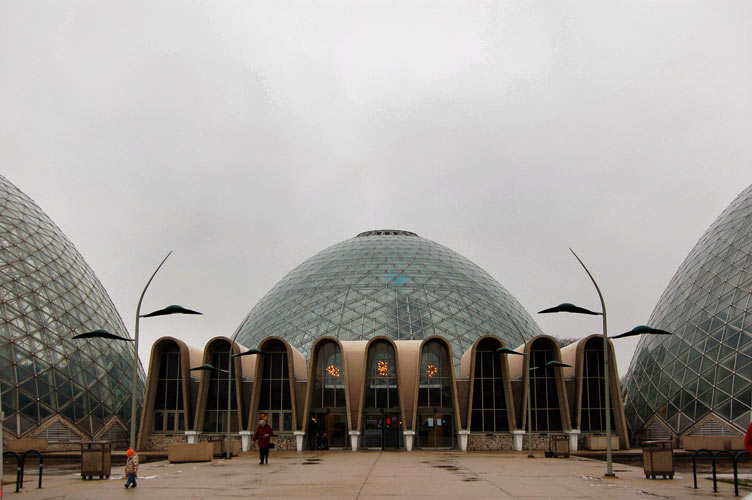No, the Domes Aren’t Great Architecture
Beloved perhaps. But let’s be honest about their kitschy design.
Mary Louise Schumacher writes in the Milwaukee Journal Sentinel that The Domes “represent a fascinating moment in architectural history” which embodied “an idealism about the future.” Writing in Urban Milwaukee Virginia Small cites a website that rates The Domes as one of the ten most significant buildings in Wisconsin. She says this puts Grieb in the company of Calatrava, Saarinen, and Frank Lloyd Wright.
I think it is fair to say the “genius” of The Domes has become a premise to the discussion of what to do with a building nearing the end of it’s natural life. “When it comes to the qualities of great architects, such as Frank Lloyd Wright or Buckminster Fuller, former,” Schmacher writes, “Milwaukee architect Donald Grieb had a host of them.”
Mostly hubris, it turns out. “What’s admirable about Grieb is that he was operating way out on the edge of his capacities,” Jim Shields of HGA Architects and Engineers told the Milwaukee Journal Sentinel.
When Grieb was working within his capacities he did the Courthouse Annex that used to hang over the freeway. With the exception of the Amtrak Station that was recently replaced by the Intermodal Station, Grieb’s career was a disaster for the city. Schumacher seems to concede this, writing that his “courthouse annex, demolished to make way for the Marquette Interchange, was a horrible hulking mass, and the inhospitable civic center spaces contributed to what’s long been regarded one of the city’s great urban design disasters.”
Yet she argues his Domes were so inventive that “everything should be done to preserve” them.
First of all, The Domes are not domes. “Grieb tweaked Buckminster Fuller’s geodesic model for the Domes,” according to Small, “to accommodate taller plants and other features.” “Tweak” is putting it kindly. Greib’s changes destroyed the Platonic coherence which made Fuller’s geodesic dome a modern icon. Schumacher calls them “beehive-shaped domes.” Does that mean we can have pear-shaped or car-shaped domes too?
The Domes’ misbegotten shape has been turned into a virtue by the press. “It was all uniformly slightly off kilter, but that just made it really kind of interesting,” said Bill Kissinger, a trained architect and director of business development at Kahler Slater, to the Journal Sentinel. Schmacher adds, “those wee design wobbles are part of the charm of the Domes, adventurous structures that remain unique in the world.”
Small says, “They’re architecturally unique. The Domes are the world’s first—and only–cone-shaped conservatory. Among horticultural conservatories, Milwaukee’s Domes are unique.”
There a reason for that — “unique” sounds good on paper but the results are almost always bad. There are exceptions, but our Domes is not one of them. Grieb was like a folk artist who looked at some pictures in magazines and decided to do “Modern Art” without understanding the underlying values and principles of what he was trying to do.
He had no idea how to execute. If the domes needed to be higher, then why not make the base bigger instead of bastardizing the forms?
The Domes have none of the virtues of Modern domes, or Modern buildings for that matter. I have always wondered why the lattice work is so fussed up. It looks crocheted except two thirds of the way up someone dropped a stitch. There is no pattern or palpable structure.
The Domes are neither transparent or translucent. They lack the beauty of Modernist rationality. The waves on the entrance of the building look like they were squished when the domes were shoved together. There is no space in this place. The whole thing is heavy when it should be light.
The Domes may be very popular with Milwaukeeans (though we’ve seen no survey on the subject). But I am pretty sure no one has ever taken their architecture class to The Domes to show students how to make a good building. Grieb created a hackneyed oddity, more architectural kitsch than anything else. There may be reasons to save The Domes. For the record, architecture is not one of them.
More about the Future of The Domes
- Milwaukee County Board Reaffirms Commitment to Redevelopment and Restoration of Mitchell Park Domes - County Board Chairwoman Marcelia Nicholson - Sep 18th, 2025
- MKE County: Committee Cautiously Approves Domes Development - Graham Kilmer - Sep 3rd, 2025
- MKE County: Crowley Approves $30 Million for Domes - Graham Kilmer - Jul 30th, 2025
- County Executive Crowley, Chairwoman Nicholson Sign Legislation Approving Plan to Redevelop and Restore Mitchell Park Domes - David Crowley - Jul 30th, 2025
- MKE County: Board Approves $30 Million Commitment For Domes - Graham Kilmer - Jul 24th, 2025
- Why Mitchell Park Needs The Domes - Graham Kilmer - Jul 22nd, 2025
- MKE County: Parks Committee Backs $30 Million Domes Deal - Graham Kilmer - Jul 8th, 2025
- MKE County: Domes Plan Requires $30 Million From County - Graham Kilmer - Jul 2nd, 2025
- MKE County: Domes Project Lining Up Key Financing Component - Graham Kilmer - Feb 28th, 2025
- MKE County: Supervisor Adds Domes Project to 2025 Budget - Graham Kilmer - Oct 24th, 2024
Read more about Future of The Domes here
In Public
-
The Good Mural
 Apr 19th, 2020 by Tom Bamberger
Apr 19th, 2020 by Tom Bamberger
-
Scooters Are the Future
 Dec 19th, 2019 by Tom Bamberger
Dec 19th, 2019 by Tom Bamberger
-
Homeless Tent City Is a Democracy
 Aug 2nd, 2019 by Tom Bamberger
Aug 2nd, 2019 by Tom Bamberger























This is part of the problem when it comes to critiquing modern architecture, by what criteria do we judge them? It’s certainly true that the Domes lack the purity of a Mies van der Roude or the brutal material honesty of Louis Kahn, and they certainly deviate from Buckminster Fuller’s geodesic domes, but I don’t know that that is the best criteria by which to judge them. I’ll concede that the vertical supports stopping about 2/3’s of the way up is less than elegant, but the effect when you step inside is really quite striking, and from the outside, the new architectural lighting that has been implemented in recent years really brings out their other-worldly appearance. They have a futurist quality that puts me in mind of the 1964 World’s Fair, a kind of optimism and exuberance that, frankly, is lacking in the work of the other architects mentioned above. Too often modernism has a cold, uninviting appearance, something I do not believe you could accuse the Domes of. What I think is lost when we only use the works of “masters” to evaluate the work of others is the human experience. Boston City Hall is regarded as a modernist masterpiece, but most non-architects absolutely loath it because it fails as a human space. The Domes are a human space. They are inviting and bright, and I feel that is just as worthy a criteria when it comes to great architecture.
I also must take issue with the accusation that they are not domes. Domes do not have to be perfect portions of spheres to be domes. Unless the Duomo also doesn’t have a dome, then these are clearly domes.
Wow, I could not disagree more! Leave it to you, Tom, to see the former Amtrak station as good architecture but the Domes as not.
The solution for making it taller is to just make the base wider? Come on… that would completely change the nature of the building.
Bamberger’s anemic aesthetic considers only simple criteria and dismisses this one-of-a-kind structure as kitschy, like Chis Abele’s diminishing comment, “McDonaldsy.” Perhaps the St Louis Gateway Arch, another conical structure should be torn down because it too could be called McDonaldsy.
A conical dome is still a dome. In fact most domes throughout history and the world are not geodesic or even perfectly round forms, which are challenge to construct. Bamberger portrays Domes architect, Grieb as a bungling engineer because his design is one-of-a-kind and had not been duplicated. In another aesthetic this is called rare.
Bamberger criticizes the lattice work of the glass. He says the building is not transparent or translucent. Would he have Paris tear the glass pyramid at the Louvre; It has a similar latticed glass work structure and also is not transparent.
Bamberger’s must not have stood in the show dome or the arid dome because both offer an incredible sense of space and light for spectators, given the limited northern light of Milwaukee.
Bamberger should have done his research because the Milwaukee Domes are listed in several architectural catalogs as outstanding or top architectural sites Wisconsin and Milwaukee.
The architectural features and uniqueness of the dome must be considered in any discussion of their value. As a unique structure The Domes have intrinsic and universal value that supersedes limited notions of modernity. Removing the Domes is like tearing down the St. Louis Arch or the Paris Louvre Pyramids.
Do the required normal maintenance; reinforce the joints and stop this nonsense.
Tom speaks the truth here. The domes have about as much architectural greatness as the dilapidated Honey Dip Donuts mini mall located across the street.
Music critic job must have been filled.
Maybe try food critic next.
I disagree.
It’s good to know that Tom Bamberger’s reputation for chronic contrarianism won’t suffer a bit with this latest screed. But really, since when do buildings have a “natural life”? That strange term sounds suspiciously like it was culled from the “work product” of the spin-meisters in Chris Abele’s employ. They regularly crank out nonsensical justifications for the public policy vandalism that Abele tries to pass off as “achieving greater efficiencies” in his relentless attacks on our beloved county parks. I expect finer reasoning from Bamberger.
Hundredsof the hoi poiloi turned out in midwinter to plead on behalf of the Domes. Could the fact that Milwaukee’s masses love the Domes be reason enough to call them kitschy? If only “great” architecture deserved to exist, precious few buildings around here would escape the raze order/verdict of vandals in high places. It’s not sustainable.
The domes are a gem both programmatically and architecturally. Tastes will always vary on style, but the domes are a heroic gesture of their time. With the constrained construction budgets today driving a processed/homogenized architectural aesthetic, its easy for me to appreciate the variety the domes bring to our skyline.
All that aside, the buildings do serve as a destination for the field trips of grade schoolers and some parents looking to do something interesting with their kids on the weekends. If we lost the domes, we would lose one more cultural asset, in a city that could arguably use a bit more.
Well fine. Let’s stipulate that the Domes aren’t works of architectural genius although they are kind of fun to see looming there. I never went to the domes to admire their architectural wonders and I don’t think anyone else did either. But they are a great place to , particularly on a cold, grey day and lots of people like to get married there. I think that’s plenty reason to preserve them. They work for us.
If only Milwaukee County had the luxury of deciding on which of its dilapidated structures to keep and which to throw away based on architectural significance, nostalgia, or otherwise.
Which is more fiscally sound for cash strapped Milwaukee County? Repairing the Domes. to last another 50 years or to tear it down and build something new to last 50 years? Those are our decisions, because I ultimately believe county citizens desire to keep a conservatory.
I don’t like public policy decisions based on fond memories. I also don’t like building something new for the sake of new. It’s a distraction that takes away from rational decision making. Lay out the numbers and see what makes fiscal sense.
What is this I see before me? An article? An assessment? No. It is most drivelous and encompasses that which it strives to impose on the architect in question.
The author’s opinion seems to exist in order to establish that it exists… and that the writer has value, and that others should recognize and laud that value, or at the very least offer opposition of the type from which the author can offer defense of self.
Far better to spend a year or two meditating somewhere until the golden light of self-knowledge descends like a great benevolence bringing water to folk on the edge of some emotional desert.
Alternately, consider this event from yesterday evening.
I was at the grocery store buying things necessary and unnecessary. This public place like many others sometimes suffers from the self involved, that is to say humans who move through parking lots without regard for pedestrians, guide their carts through aisles nearly all their faculties focused on cell phones thus explaining the need for children and the infirm to leap away from the hurtling, wheeled structure. Comprehension not dawning, the navigator later blocks an entire aisle nexus bringing progress to a halt, perhaps unconsciously.
Imagine then some rude fellow such as myself, and admittedly in support of a wholly separate shopping initiative, moves the cart out of the way, upon which action that cart’s former navigator lunges swiftly to recapture the cart. Offering a look of astonishment and hurt, the pilot of their individual desire engages in advanced discovery of an aisle far from the event. Being an insolent fellow, I wonder whether it would have been better had we engaged in discussion. That bad idea drains into the grate beneath the freezer section. After all, had the navigator of all dreams narrow been confrontational, I would likely have begged she be a philosopher of no mean capability*. Much better that occur than the mere fact of a flawed being offering criticism of another flawed being. Don’t you agree?
* I could have said capacity, but really, we’re talking about capability or should be.
One option is to fix “DOMES” and redesign a new front entrance lobby.
Having become a go-to source on the work of Donald Grieb since Whitney Gould wrote about plans to replace the Amtrak station more than a decade ago, I feel compelled to comment. No serious person would mistake the domes or any of Grieb’s work as great architecture. To put him in the same sentence with Wright, Saarinen of Calatrava is simply silly.
What I have maintained is that his work is “interesting.” And, though it doesn’t come through in print, this is meant to be something less than a compliment but not an outright repudiation of his work. Rather, it is meant to acknowledge the very weirdness of the man’s work and to marvel at his ability to get it built in the first place. I, along with Jim Shields and Vincent James, who are also quoted in the Schumacher piece know how difficult it is for any architect to win an important public commission such as the building that came to be known as the Domes. With almost no exceptions, no other architect that I can think of was as successful in winning the important commissions of his day. This despite the manifest weirdness of his vision. That is why Grieb matters
Grieb’s success is representative of the spirit of the late 50s and the 60s: Fearless, hubristic, experimental and frequently misguided. There is no longer room in civic architecture for any of this. With the exception of the Calatrava, what other important public building has been built in Milwaukee in the past 40 years that one could call spirited? Fearless? Experimental? (Okay, the Bayview branch of the Milwaukee Public Library) It seems only hubris and misguidedness.remain.
But this is not even what makes the work “interesting” (Schumacher mentioned that Jim and I have talked for years about a fictional monograph we call “The Interesting Vision of Donald Grieb”) What makes it interesting is the man’s utter commitment to the development of a singular vision of architecture that was so utterly weird, or as the author puts it, “Kitsch.” It is what I would call “a fabulous disaster,” a thing to behold in wonder without reference to taste.
Though Grieb’s other buildings, including the work referenced in the story may be particularly tasteless, they are, for the most part of a piece: formally experimental but not technically innovative. The Domes stand apart. The video that accompanied Schumacher’s February article in the JS shows the building being made using unprecedented methods. The fact that they have lasted as long as they have is itself a wonder, given the unproven (and by today’s standards, remarkably crude) technology that was used to make the innovative modular forms that form the domes. Grieb was way out on a limb with his design and it worked out a whole lot better and proved to be more durable than it should have.
Returning to the subject of kitsch, I would suggest that the architects and engineers so reverently mentioned, Saarinen, Fuller and yes, even Calatrava have all at one point or another wandered into the world of kitsch. St Louis Arch (Saarinen), pure kitsch. Dymaxion anything (Fuller) kitsch AND goofy, Monona Terrace, the Greek Orthodox Church (Wright) bombastic and way beyond kitsch. It is kind of what we think of when we recall that era. Kitsch is sometimes what you get when experiments go awry.
There is a small limb on the tree of architectural movements or styles called Googie, It is a kitsch style elevated to something enduring and often endearing in its weirdness and spirit. http://www.smithsonianmag.com/history/googie-architecture-of-the-space-age-122837470/. The Domes fall squarely into the world of Googie as do some works by many of the mid-century giants of architecture. That doesn’t make it good or bad architecture per se, but it does offer a lens with which to appreciate the domes without reference to conventional notions of “good” or “bad” architecture.
I agree that the Domes aren’t good architecture. But they sure as heck are amusing and uplifting and in an odd way even inspiring. And, they beat the heck out of most of the bland, unoriginal and unadventurous work that is filling up the downtowns of most American cities today, including Milwaukee.
Bill – impressively interesting perspective and eloquently articulated. I think you hit the nail on the head.
Wow David Nelson, that’s some impressive bloviation… I wish I could be as impressed with myself for saying so much with so little meaning.
I generally agree with your opinion, but you probably could have said the same thing in one sentence.
AG: I find that a little poetic license is sometimes the only thing that wakes the sleeping. Not saying what I wrote was poetry.
People tend to be human without giving credit to other’s humanity. That also explains a lot from the right of the spectrum.
I don’t think people love the Domes but they do love what they contain. No one goes to the Domes for the architecture but for the natural beauty inside. They are horribly ugly from the outside.
If the county goes down the road of tearing them down they better do a very good job assuring the public that the Domes will be back and better than ever. With the engineering technology that is available today we could have something very special. The one hold over that I personally would insist on is that there are 3 individual domes.
Thanks, Bill Kissinger, for clarifying your viewpoints on Grieb and the Domes, including architectural vision, cultural relevance and historical context, as well as formal aesthetics.
Here’s info about e-architect, the website I previously quoted that lists the Domes among 10 “architecturally significant buildings” in Wisconsin (a list in progress):
http://www.e-architect.co.uk/america/wisconsin-architecture
“e-architect is one of the world’s largest architecture websites with around 19,000 pages. e-architect is run by Adrian Welch and Isabelle Lomholt. Adrian and Isabelle both trained as architects but their strong interest in architecture led them to focus their energies on an online architectural resource rather than practicing.” Their agenda: “Of course we have strong views on architecture, but our policy is to focus on getting regular news about the most interesting buildings and on building up a useful, wide-ranging architectural resource…” We select projects that interest us…and have views that sometimes differ.”
Their notes about the Wisconsin list: “We’ve selected what we feel are the key examples of Wisconsin Buildings, USA. We aim to include projects that are either of top quality or interesting, or ideally both. We cover completed Wisconsin buildings, new building designs, architectural exhibitions and architecture competitions across the state. The focus is on contemporary buildings but information on traditional buildings is also welcome.” Sounds like an open invitation…
Docomomo (International Committee for the documentation and conservation of buildings, sites and neighborhoods of the Modernist Movement) is monitoring the Domes’ future and The Cultural Landscape Foundation have listed them as at risk.
As Christopher Hillard noted, there are various types of domes (at least a dozen liisted). Beehive-style domes date back to the Bronze Age. They’re also called “conoidal” or cone-shaped. https://en.wikipedia.org/wiki/Dome
The first “geodesic” dome was designed by Walther Baersfeld and opened as an planetarium in 1926 in Germany. Buckminster Fuller popularized the design by using it often starting in the 1950s.
Statements about the Domes being “unique-in-the-world” and a “living landmark” are quoted from Friends of the Domes.
Hideous! I always felt slightly ashamed of what folks worship when I took my kids there back in the dim 60s. Thanks Mr. Bamberger, and gee whiz, some of you readers have thin skins!
To those commentators who consider this merely evidence of Bamberger’s crankiness, consider this: Like him or not, agree with him or don’t, but keep in mind that without his regular missives there would be no one writing serious criticism about Milwaukee’s architecture and public spaces.
Consider also Bamberger and Bruce Murphy’s role in shaming the Milwaukee Art Museum into re-engaging with architect Jim Shields and abandoning a ridiculous scheme for their latest addition. The MAM changed course when they realized that someone who knows something about design was actually watching and was prepared to call them out. That is why criticism matters.
Meanwhile, those who have not been skewered by the critic’s pen continue to crank out the same junkitecture that is filling up Walker’s Point, the Beerline, The Park East and the other development hotspots. And that is how the city is degraded one bad building at a time: no one seems to be watching or cares enough to speak up.
Finally, for those who think Bamberger is always a sourpuss, note that he could find not a single flaw with Shield’s built design for MAM: http://urbanmilwaukee.com/2016/01/13/in-public-guided-by-the-light/
Good points, Bill K. Tom has generated good dialogue about architecture and public space issues (including his recent piece about the lack of decent seating, the Lakefront Gateway project, Art Stop, etc.). Christopher Hillard has also written fine pieces about Milwaukee architecture in UM. It sounds like you are also among those trying to set a higher bar. Keep it up!
And yes, there is much junkitecture springing up everywhere. And, sadly, many of Milwaukee’s public spaces are lackluster or chronically threatened by defunding.
I hope people will turn out for Tuesday’s Turner Hall forum about the legacy of Jane Jacobs (co-sponsored by UM). Government officials call a lot of shots about what gets built (or not) and our public realm. But a key Jacobs message is that it’s up to citizens to engage deeply about how they want their cities to look, feel and function. Criticism has its place, as does activism. That’s the cure for defeatism and settling for ho-hum or worse. But it takes effort to resist profound groupthink and overcome skittishness about speaking out about civic horrors and a nondescript or neglected public realm.
“With the exception of the Calatrava, what other important public building has been built in Milwaukee in the past 40 years that one could call spirited? Fearless? Experimental?”
Although the MAM’s Calatrava addition feels like a public building, and MAM has a quasi-public mission, I think it was completely funded by private donations and is privately owned (although the county owns the land). The War Memorial, however, was built with public funds, though now it will be fully owned/managed by MAM and the veterans group.
Indeed, in its most effective form — journalism like this can be crucial to catalyze change — but it requires careful scrutiny of topics (like urban architecture, etc.) as well as criticism (constructive or not). Otherwise it becomes difficult to maintain the integrity of efficient checks and balances in civic and bureaucratic realms among others.
It should be no secret that a certain degree of watchdog reporting is always imperative — regardless of location or medium. Yet, these tried and true tenets — and foundation for the profession are becoming scarce. The results of post-recession corporate inspired missions to perpetually cut costs in an industry that didn’t rebound and never will. Over the past 6-8 years, the dumbing down of journalism products in general have been painfully obvious — from local levels to.national, network and beyond.
All the more reason that outlets like Urban Milwaukee and articles like this one on the domes help to enhance comprehensive knowledge on key issues — which might otherwise be muddled and misinterpreted by flocks of folks who don’t know any better. All people (from ignorant and obtuse to scholarly and open-minded) deserve options to better cultivate understanding that will ultimately enable the formulation of substantive personal opinions.
At the same time, everyone should think twice before seeking civic empowerment enabled by learning that is gained by simply perusing the formally familiar ole’ local newspaper. If you haven’t noticed by now — recent incarnations of Milwaukee’s emaciated daily dishrag — are a far cry from the robust and reputable Journal Sentinel that your FATHER used to read. The printed product that once played such a crucial role for readers in the general public has now, like so many others,been enveloped into cost cutting paradigms effected by the post-recession barrage of corporate media mergers, purges and acquisitions.
Sadly, it’s a survival mechanism. Journalistic originality, quality, accuracy and credibility are being sacrificed. Eventually replaced by less experienced, lower paid professionals. Their mandate is simple and absolute … to mindlessly mass produce more generic content/copy that can be cheaply shared to boost the bottom line. Sadly, ‘evergreen’ seems to be replacing ‘editorial’ and ‘investigative’ journalism.
Am I the only one that thinks it is ridiculous that the design only lasted 50 years? I think that is pathetic. If form follows function, we should be able to have a stunning conservatory that lasts more than a few decades. Milwaukee is full of wonderful architecture that is already older than the domes. Milwaukee deserves a design that represents conservation, beauty and can hold beautiful plants.
Denise, the structure itself isn’t going to collapse… the concrete crumbling isn’t a structural element. In fact, the parts it is closed for are crumbling because no one kept the drain holes clean for condensation the architect knew would form on the glass. There are additional problems as well, but this is the culprit in the current closing.